An ocean in the school lab: carbon dioxide at sea Teach article
Did you know that carbon dioxide dissolves in bodies of water and affects the ocean? Explore the effect of carbon dioxide on ocean chemistry with these practical activities.

Chemistry of carbon dioxide in the ocean
The ocean plays an important role in the Earth’s climate. Although it is a complex system, interconnecting all parts of the globe, the ocean obeys simple laws of physics and chemistry that can be used to raise awareness of the dynamics of the ocean and its impact on our lives.
The increasing concentration of carbon dioxide in the Earth’s atmosphere due to human activities, like burning fossil fuels (main source of anthropogenic carbon dioxide), changes the atmosphere and makes the ocean more acidic. The topic of ocean acidification naturally ties into the curriculum topics of acids and bases, pH, and even precipitation reactions.
Rain is naturally acidic (pH around 5.6) because it dissolves carbon dioxide from the atmosphere to form carbonic acid:
Unlike rain, the ocean is alkaline (pH slightly above 8) because it contains carbonates and hydrogen carbonate ions. The ocean is thus an important repository of anthropogenic carbon dioxide, removing it from the atmosphere. This might seem like a good thing, but it results in lower pH and changes to the ocean’s chemistry. Acidification of the ocean affects the availability of carbonate ions, an important component of shells. Carbon dioxide is dissolved in the ocean to form carbonic acid, which reacts with carbonate ions. Thus, amounts of carbonate ions decrease and hydrogen carbonate ions increase:
Activity 1: Carbon dioxide and water pH – Part I
This experiment shows how carbon dioxide changes the pH of the water and why the rain is naturally acidic. The colour changes of the universal indicators make the experiment more appealing to younger students.
Materials
- 2 Erlenmeyer flasks (100 cm3)
- Fresh water (40 cm3)
- Straws
- Universal indicator or bromothymol blue (5 to 7 drops)
The colours of the indicators are shown in figure 1. In all figures shown here, bromothymol blue is used.
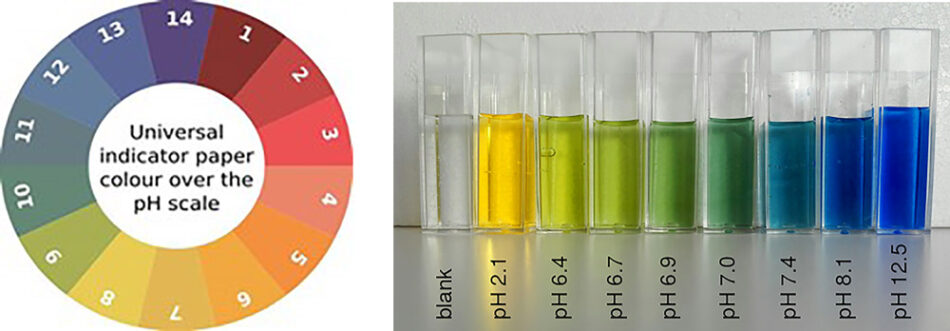
Image: Gregor Trefalt/Wikimedia, CC BY-SA 4.0
Procedure
- Students fill the flask with 40 cm3 fresh water. You can also try this with sea water or make your own by dissolving about 3.5 g of sea salt in 100 cm3 of water.
- Add drops of pH indicator to each flask and measure the pH.
- In one flask, using a straw, slowly blow air into the water.
- Students should observe changes in colour (figure 2) and note the new pH values.
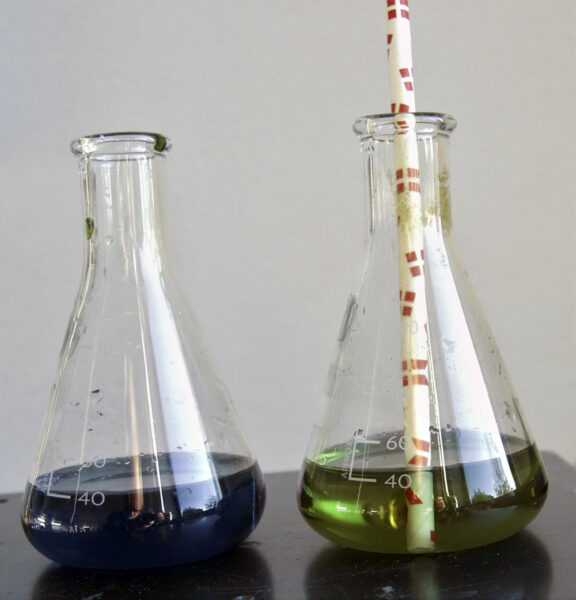
Image courtesy of Ole Ahlgren
Activity 2: Carbon dioxide and water pH – Part II
Carbon dioxide is not bubbled into the ocean. Contact between the ocean and the atmosphere is enough for the gas to be dissolved. This experiment is a better representation of what happens naturally in the ocean, but the results are not so immediate.
Materials
- 250 cm3 beaker with rubber stopper
- 250 cm3 Erlenmeyer flask
- 50 cm3 tap water with about 10 drops of universal indicator or bromothymol blue
- 10 cm3 Vinegar (acetic acid)
- Baking soda (2 tablespoons)
- Matches (optional)
Procedure
- Students add the vinegar slowly to about 2 teaspoons of baking soda in the Erlenmeyer flask (figure 3). When fizzing stops, students can test if the beaker is full of carbon dioxide by placing a lit match in it. The match will go out in the presence of CO2.
- Students then ‘pour’ the gas into a beaker, containing 50 cm3 water with indicator, which is then closed with the rubber stopper.
- Carbon dioxide will slowly dissolve in water, but it can take up to a day to observe any change in pH (figure 3).

Image courtesy of Ole Ahlgren
Activity 3: Carbon dioxide from burning wood
An alternative to Activity 2 involves burning a wooden stick, for example, a match, to produce carbon dioxide above the surface of water. This scenario is closer to the real-life burning of fossil fuels and will produce similar results.
Materials
- 100 cm3 Erlenmeyer flask with rubber stopper
- 20 cm3 tap water with about 5 drops of universal indicator
- Wooden stick
Procedure
- Students put 20 cm3 water containing indicator into the flask and measure the pH.
- Students must wear safety glasses. A small wooden stick is ignited and held down into the flask (figure 4) until the flame is extinguished due to a lack of sufficient oxygen to sustain combustion.
- The flask is closed using the stopper and shaken for a few seconds.
- The indicator changes colour, and the pH of water is measured again (figure 4).
- When shaking the flask, CO2 is quickly absorbed by the water. In real life, this is a slow process. To illustrate this, repeat without shaking and leave the stoppered flask at rest for several hours to see the colour change when CO2 is absorbed.
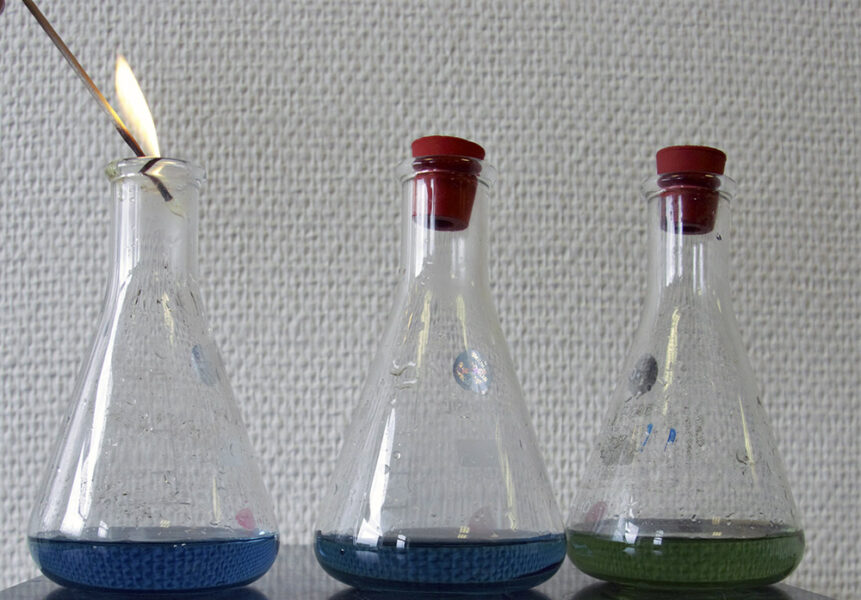
Image courtesy of Ole Ahlgren
Safety note
Students should wear safety glasses during this activity.
Activity 4: Carbon dioxide and carbonate ions
This experiment will qualitatively reveal the amount of carbonate available in solution.
Calcium carbonate is insoluble in water, unlike calcium hydrogen carbonate, which is very soluble. When we add calcium ions (from a calcium nitrate solution) to a solution with carbonate ions (from a sodium carbonate solution), we should observe the formation of a white precipitate of calcium carbonate, one of the constituents of seashells. If we lower the pH, we can observe how this affects the amount of carbonate available in the solution by the amount of calcium carbonate that precipitates.
Materials and reagents
- Na2CO3 (0.05 mol/dm3 solution (0.52 g Na2CO3 in 100 cm3 H2O)
- HNO3 (1 mol/dm3 solution)
- Ca(NO3)2 (0.03 mol/dm3 solution (0.33 g Ca(NO3)2 in 100 cm3 H2O))
- 3 test tubes
- pH meter or pH test strips
Procedure
- Students add 5 cm3 Na2CO3 solution to each of three test tubes (A, B, and C; figure 5).
- Add 10 drops of HNO3 solution to tube A, 5 drops to tube B, and none to tube C (control).
- With the pH meter or test strip, measure the pH in each tube and then add 1 cm3 Ca(NO3)2 solution (or around 25 drops) to each tube.
- Students then observe the results and reach a conclusion regarding which solution has more carbonate available for precipitation as calcium carbonate.
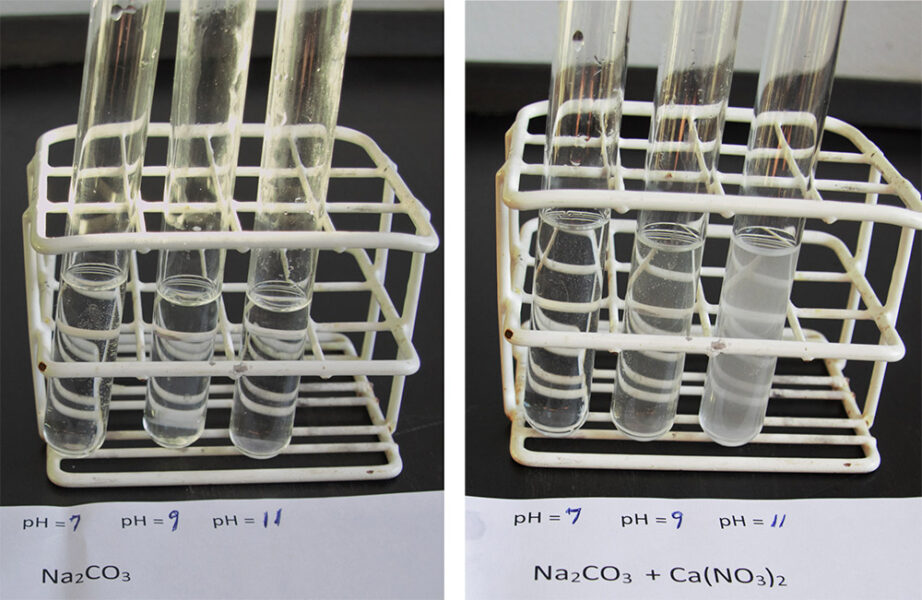
Image courtesy of Ole Ahlgren
Discussion
For younger students, the results can be explained in a simpler way by saying that water has dissolved carbonate ions (CO32-), hydrogen carbonate ions (HCO3–), and carbonic acid (H2CO3). The last one can be converted into water and carbon dioxide. The relative amount of each species depends on the pH of the solution. In the solution with lower pH, there are very few carbonates and more carbonic acid, which is decomposed, so we can see carbon dioxide forming. For older students, the results can be explained in a more complex way using the following chemical equations, the concepts of chemical equilibrium, and Le Chatelier’s principle.
After dissolving CaCO3 in water (solution with high pH):
After adding HNO3:
A more acidic solution shifts the equilibrium to the right, so, according to Le Chatelier’s principle, less is available. In tube A, the equilibrium is shifted so far to the right that CO2 is observed by the formation of bubbles.
After adding Ca(NO3)2:
The solution with the most white precipitate will be the one with most carbonate ions available; in this case, it is tube C, which contains sodium carbonate (pH=11) and no nitric acid (HNO3).
Consequences for ocean life
The increase in atmospheric carbon dioxide due to human activity has an impact on the ocean. About 30% of this gas is absorbed by the ocean and a fraction reacts with the water to form carbonic acid. This weak acid causes acidification of the ocean by lowering the pH. The term ocean acidification, despite being correct, might be misleading, since the ocean is alkaline with a pH of around 8.1 (figure 6).[1]
But, even if the ocean remains alkaline, a drop in pH affects biochemical reactions within an organism and the formation of structures in calcareous marine organisms.[2,3]
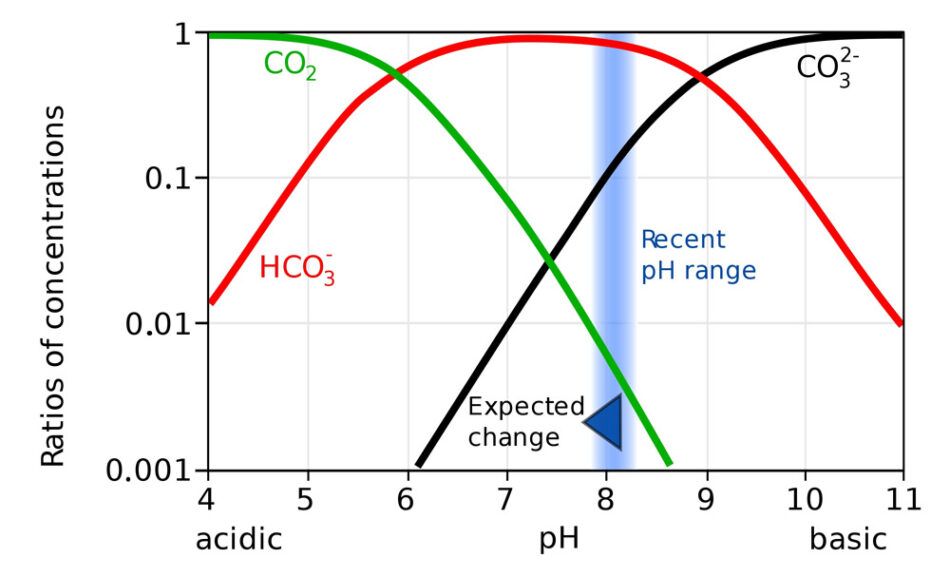
Image: Public Domain
According to figure 6, as the pH drops, the amount of carbonate ions drops as well, making them less available. Carbonate ions are transformed into hydrogen carbonate ions and carbon dioxide. This is why in Activity 4, at pH 7, the formation of a gas is observed.
Questions to ask students
- Why does the water in Activity 1 change colour when blowing into it?
- How does the experiment in Activity 3 illustrate a consequence of burning fossil fuels?
- Explain the difference in precipitates in the three test tubes in Activity 4 based on figure 5 and figure 6.
- People sometimes illustrate a consequence of the acidification of the ocean by putting shells into acid. Why is this experiment misleading?
- If the pH of the ocean drops from 8.1 to 8.0, by approximately how much will the ratio of carbonate ions decrease, according to figure 6?
References
[1] An article on ocean acidification by the National Oceanic and Atmospheric Administration (NOAA): https://www.noaa.gov/education/resource-collections/ocean-coasts/ocean-acidification
[2] A report on the consequences of ocean acidification: https://worldoceanreview.com/en/wor-1/ocean-chemistry/acidification/
[3] A report on how climate change alters ocean chemistry: https://worldoceanreview.com/en/wor-1/ocean-chemistry/
Resources
- Try more ocean-related activities: Ribeiro C I, Ahlgren O (2021) An ocean in the school lab: rising sea levels. Science in School 53.
- Learn more about how ocean acidification affects seal life: Korn A (2016) Opening seashells to reveal climate secrets. Science in School 35:12–14.
- Read about the role of our oceans in climate change: Harrison T, Khan A, Shallcross D (2017) Climate change: why the oceans matter. Science in School 39: 12–15.
- Find out about the physics at work beneath the waves with these classroom experiments: Watt S (2012) Movers and shakers: physics in the oceans. Science in School 25: 28–33.
- Explore other chemistry experiments relevant to climate change: Shallcross D, Harrison T (2008) Practical demonstrations to augment climate change lessons. Science in School 10:46–50.
- Read about the impact of human activity on climate change and its consequences for the Earth: Follows M (2019) Ten things that affect our climate. Science in School 47:19–25.
- Find out how the consequences of climate change are already having an impact on communities: Unwin H (2020) The social science of climate change. Science in School 49:18–22.
- Find related hands-on activities at Earth Learning Idea.
Review
Carbon dioxide and its impacts are rarely out of the news. In this article, Ribeiro and Ahlgren bring together three simple practicals to help underpin the teaching of the chemistry involved as the world’s oceans dissolve carbon dioxide.
Through increasing complexity, the authors explore a range of important ideas including: the differences in acidity between sea water and drinking water, the impact of dissolving carbon dioxide on pH and finally looking at the equilibria between carbonate and hydrogencarbonate ions. Their final experiment offers useful extensions for more gifted students providing a way into discussions about Le Chatelier.These experiments should offer teachers a useful addition to the explanation of what is often seen as a more theoretical part of the curriculum.
Dr Chris Millington, Teacher of Chemistry, Oldham Hulme Grammar, UK





